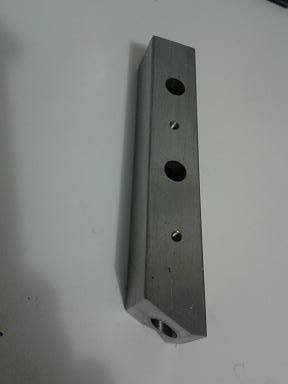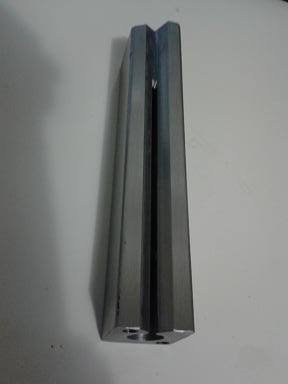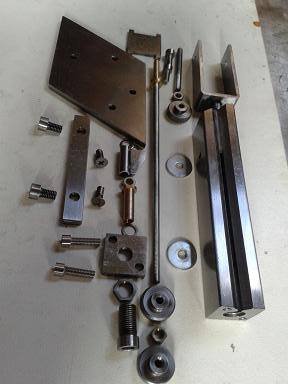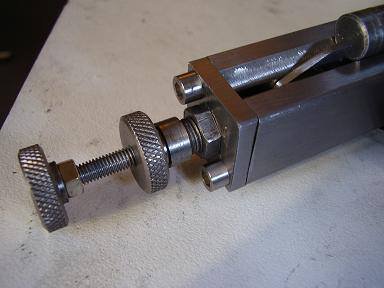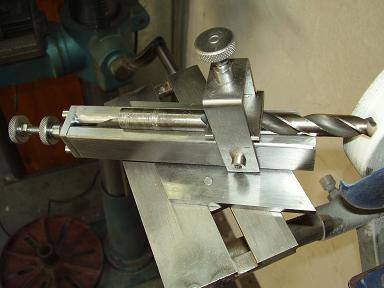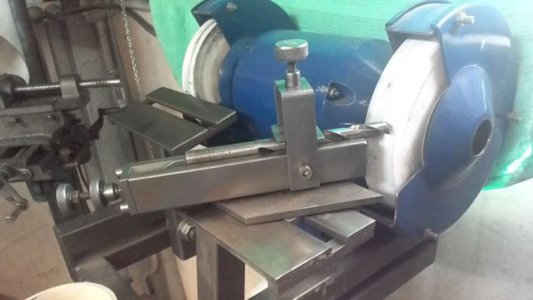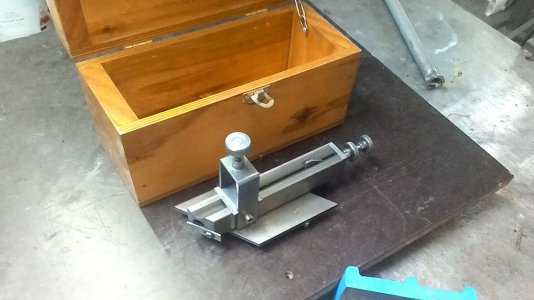I normally sharpen drills by hand/eye, but I have used this on occasion to good effect. It's particularly good for sharpening drills when you require an accurately sized hole without resorting to a reamer. When sharpening by hand, no matter how good you think you are, there will always be some discrepancy in the length of the cutting shoulders, so the hole it drills will be equal to twice the length of the longest shoulder, this isn't normally a problem with jigs.
I made the main body from 25mm square stock, machined a V on one side and cut a slot in the bottom of the V. There's a hole through miiddle which contains a 6mm threaded rod. riding on the threaded rod is a nut to which I welded a fin the fin pokes through the slot into the V. The end of the threaded rod has a knurled adjusting knob and a knurled locking nut.
I vaguely remember including an advance rod backlash adjuster, but can't remember how I did it.
On top of the main body is a U shaped bracket with a clamping screw, the clamping screw acts on an H plate which slides up and down inside the U shaped bracket, that clamps the drill bit in place and the shark fin nut acts on the back of the drill bit thus advancing it. At the front there is a tapped hole for attaching an indexing pointer but I've never used it.
The main body is attached to a 6mm plate which has a 12mm guide plate fastened underneath. The angle is set at 118 degrees and is not adjustable.
The jig is useless by itself, so I made a table with a 12mm slot across the middle in which the guide plate runs. So to use, clamp the drill in place and slide the jig across the table, thus grinding a facet. To advance the drill, turn the knob and lock it off with the locking nut, when one side is done, turn the drill over 180 degrees using the indexing pointer and repeat.
Cutting angle and relief angle are adjustable by angling the table. I do have marks on the table for this, but they are useless as the wheel gets smaller with use, making the marks redundant.
Probably over complicated in design, but it is simple to use and it works well. You can grind the web thinner at the tip with a diamond wheel, but I've never found it necessary as a conically sharpened drill has more of a chisel point that a facet sharpened drill has.
Now before you feel moved to point out one shoulder of the drill looks longer than the other, take a look at the angle of the drill to the camera, nuff said?
I made a wooden box for it and, in Chinese script, wrote 'drill sharpening jig' on top. Just to give it a bit of cred, we all know the best tools come from China, right
At least that's what I hope it says, not being. Chinese I have no idea, but I looked it up on the Web.
I made the main body from 25mm square stock, machined a V on one side and cut a slot in the bottom of the V. There's a hole through miiddle which contains a 6mm threaded rod. riding on the threaded rod is a nut to which I welded a fin the fin pokes through the slot into the V. The end of the threaded rod has a knurled adjusting knob and a knurled locking nut.
I vaguely remember including an advance rod backlash adjuster, but can't remember how I did it.
On top of the main body is a U shaped bracket with a clamping screw, the clamping screw acts on an H plate which slides up and down inside the U shaped bracket, that clamps the drill bit in place and the shark fin nut acts on the back of the drill bit thus advancing it. At the front there is a tapped hole for attaching an indexing pointer but I've never used it.
The main body is attached to a 6mm plate which has a 12mm guide plate fastened underneath. The angle is set at 118 degrees and is not adjustable.
The jig is useless by itself, so I made a table with a 12mm slot across the middle in which the guide plate runs. So to use, clamp the drill in place and slide the jig across the table, thus grinding a facet. To advance the drill, turn the knob and lock it off with the locking nut, when one side is done, turn the drill over 180 degrees using the indexing pointer and repeat.
Cutting angle and relief angle are adjustable by angling the table. I do have marks on the table for this, but they are useless as the wheel gets smaller with use, making the marks redundant.
Probably over complicated in design, but it is simple to use and it works well. You can grind the web thinner at the tip with a diamond wheel, but I've never found it necessary as a conically sharpened drill has more of a chisel point that a facet sharpened drill has.
Now before you feel moved to point out one shoulder of the drill looks longer than the other, take a look at the angle of the drill to the camera, nuff said?
I made a wooden box for it and, in Chinese script, wrote 'drill sharpening jig' on top. Just to give it a bit of cred, we all know the best tools come from China, right
At least that's what I hope it says, not being. Chinese I have no idea, but I looked it up on the Web.


